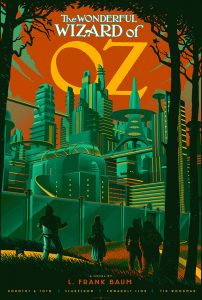 Outside of two tales in SHORT STORIES and another reprinted in MYSTERY MAGAZINE, L. Frank Baum certainly isn’t considered a pulp writer. He’s primarily known for his children’s books, particularly THE WONDERFUL WIZARD OF OZ and its sequels. So why was PulpFest 2020 planning to host a Baum presentation? What gives?
Outside of two tales in SHORT STORIES and another reprinted in MYSTERY MAGAZINE, L. Frank Baum certainly isn’t considered a pulp writer. He’s primarily known for his children’s books, particularly THE WONDERFUL WIZARD OF OZ and its sequels. So why was PulpFest 2020 planning to host a Baum presentation? What gives?
Why it’s all because of Aunt Neva, of course!
Ray Bradbury’s aunt was just ten years older than her nephew “Shorty.” Still, it was Neva Bradbury who introduced Ray to the fantastic:
“My aunt Neva helped bring me up in a world of let’s pretend, in a world of masks and puppets that she made, in a world of stages and acting, in a world of special Christmases and Halloweens. It was she who read me my first fairy tales, she who read Poe aloud to me when I was seven and taught me all about fabulous mythological country from which I never quite emerged.”
In other words, it was Aunt Neva Bradbury who taught young Ray all about the wonderful world of Oz.
The Yellow Brick Road to the Pulps
Excluding Native American myths, American culture lacks traditional mythological heroes. Certainly, it has some — Paul Bunyan, Johnny Appleseed, Pecos Bill, and John Henry, for example — but the dramatic kings and queens, knights and sorcerers are simply not present.
In the 19th century, American children were raised with hero tales that didn’t quite jibe with their own lives. L. Frank Baum changed all that when he published the first of his celebrated children’s books, THE WONDERFUL WIZARD OF OZ in 1900. In the Second Edition to Baum’s AMERICAN FAIRY TALES, published a few years later, he writes that American boys and girls will now have fairy tale adventures set in their own country, and that “…there is no good reason why they [fairies] should not inhabit our favored land….” It was a ground-breaking idea that gave American children permission to dream about adventures starting in their own backyards.
Baum was a pioneer in other ways, too. In THE WONDERFUL WIZARD OF OZ, Dorothy Gale is remarkable simply because she is ordinary and not a princess in disguise. Baum’s storytelling style is refreshingly informal, and finger-shaking morality sinks to subtext. He makes it perfectly clear that everyone, no matter how humble, has the right and power to define their own destinies. His straightforward, steadfast American heroes and heroines inspired children for generations to come. Baum’s last Oz story, GLINDA OF OZ (1920), was published posthumously and came out the same year as Ray Bradbury’s birth.
Ray Bradbury’s family encouraged creativity and his early life was filled with stage magicians, comic strip heroes, and fantastical books and plays. As a child, he wanted to be a magician and in a 1952 interview states that he transferred his “methods of magic from the stage to a sheet of Eaton’s Bond paper — for there is something of the magician in every writer….” These miracles related, not only, to the writer’s craft but also to Bradbury’s — like Baum’s — penchant for creating the miraculous out of the ordinary.
In ZEN IN THE ART OF WRITING: ESSAYS ON CREATIVITY (1990), Bradbury talks about how his early experiences became the seeds of later stories. One of his personal writing exercises involved creating lists of nouns and using them as jumping-off points for stories and characters. In childhood, he met a carnival stage magician called, Mr. Electrico, who commanded the boy to “Live forever!” Bradbury revisits “Mr. Electrico” in his 1962 novel, SOMETHING WICKED THIS WAY COMES, transforming him into the carnival master,”Mr. Dark,” who lives off the life force of others. Both SOMETHING WICKED THIS WAY COMES and his earlier work, DANDELION WINE (1957), are highly-personal stories, and both are set in the same fictitious town which stands in for his hometown of Waukegan, Illinois.
In later works, Bradbury becomes more philosophical, exploring themes of nuclear war, racism, censorship, and military threats by foreign powers. But even in these works, there remains a sense of nostalgia for a simpler life and ordinary miracles. As the 20th century became more complex, homespun ideas and straightforward narratives seemed faded and unsophisticated. After all, what is the value of a simple stage magician when faced with the doom of nuclear war? Perhaps during the pulp era something might have been said about that in science fiction, but not later. Story styles had just changed too much.
It’s tempting to believe that in the latter half of the 20th century Baum’s work was also relegated to nostalgia. Or was it? Doors still open to Oz in television shows and movies. The humbug behind the curtain has become popularized myth, and the ruby slippers (from the 1939 movie, as Dorothy’s slippers are silver in the books) represent the comfort of finding one’s way home.
THE WONDERFUL WIZARD OF OZ was the beginning of a mythical journey for American children, one that is still followed today. Certainly, it has been partially obscured under the glitter of Hollywood’s treatment and later stories by other authors. But the sparkle remains, for what ordinary person is not a hero in their own life? Baum made this possible for us, and Ray Bradbury took up his pen to follow.
(Sara Light-Waller is a writer, illustrator, and avid pulp fan. Science fiction pulps are her favorites, especially space opera and thought variant stories. The Grand Prize winner of the 2020 Cosmos Prize — offered by First Fandom Experience for the best ending to the seventeen-part round-robin story that began in June 1933 — Sara has also published two illustrated New Pulp books with more to come. Catch up with her at Lucina Press where you can learn about her work and so much more.
Pictured here is Laurent Durieux’s poster art for L. Frank Baum’s THE WONDERFUL WIZARD OF OZ. A designer and teacher for nearly three decades, the fifty-year-old Brussels illustrator and graphic artist began to draw seriously upon discovering the work of Jean Giraud — better known as Moebius. According to Ben Marks, Durieux studied at the Graphic Communication at l’Ecole Nationale Superieure des Arts Visuels de la Cambre with Luc Van Malderen. Durieux’s work is popular throughout the world.
Ray Bradbury’s first book, DARK CARNIVAL, published by Arkham House in 1947, is dedicated to his Aunt Neva Bradbury:
“Auntie Neva, with all of my love and my thanks — because years ago, you told me magical tales and played me magical music when you were a very magical person — and some of the magic stayed with me and came out in these stories . . .”)






